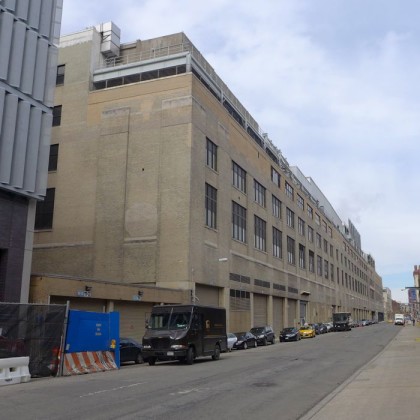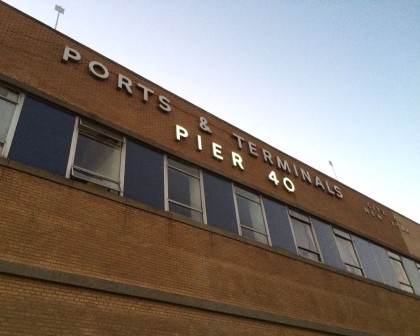Pier 40 Rescue Plan Announced
 The New York Times got advance word on the newest plan to rescue Pier 40.
The New York Times got advance word on the newest plan to rescue Pier 40.
The plan, which still needs to go through a public approval process, envisions raising more than $100 million by selling the air rights to allow the development of five buildings between Clarkson and Charlton Streets, on the eastern flank of the highway, that would include hundreds of apartments for low- and middle-income households. […] The project, being developed by Westbrook Partners and Atlas Capital Group L.L.C., will include five buildings ranging from 240 feet to 430 feet tall, rising on the site of the St. John’s Warehouse [550 Washington]. It will create 1.7 million square feet of floor space, of which 1.3 million will be devoted to housing, with 1,586 residential units created. Thirty percent of those units would be a mix of low-income, moderate-income and senior housing. […] The current proposal will be subject to public review by Manhattan Community Board 2, the borough president, the Planning Commission and the City Council.
The St. John’s Warehouse runs to Spring (as pictured above); presumably the part from Charlton to Spring will be market-rate real estate. As for the 500-ish “low-income, moderate-income and senior housing” units, I’ll say it again: Where will they shop and eat in a part of Manhattan that’s increasingly pricing out any non-upscale retailer?















What’s the occupancy limit for the island of Manhattan? Is the sky the limit?
The sky is the limit only when it comes to property taxes.
Seriously, is there no occupancy limit for Manhattan? There doesn’t seem to be an increase in police, fire, tunnels, bridges, subway, Food Emporiums or Soul Cycles to correlate with the increase in population? What is City Planning for? Just a college course? Talk amongst yourselves…
Don’t knock this. At least CB 2 gets to consider affordable something. When has our CB 1 ever negotiated with any developer ever to include affordable units ever? Test to follow.
An apartment or building has an occupancy limit, a wedding reception has an occupancy limit, the deck of the Intrepid has an occupancy limit, how does the island of Manhattan NOT have an occupancy limit? Who gives four shits about affordable housing or unaffordable housing, how about we can’t have 50 people living in a studio apartment (metaphor)!
Why are developers forced to sell their property at artificially suppressed prices? Using that logic, shouldn’t any retailer be required to sell a portion of their inventory at a reduced price to those who’s income is below the area’s median?
They are not. They get a bonus to build more full price housing in exchange for the affordable housing (unlike existing units under rent stabilization.)
http://www.nyc.gov/html/dcp/html/zone/zh_inclu_housing.shtml
The Inclusionary Housing Program (IHP) promotes economic integration in areas of the City undergoing substantial new residential development by offering an optional floor area bonus in exchange for the creation or preservation of affordable housing, on-site or off-site, principally for low-income households. […]
The Inclusionary Housing Program requires a percentage of the dwelling units within a building to be set aside, or new or rehabilitated affordable units be provided off-site within the same community district or within one-half mile of the bonused development. All affordable residential units created through the Inclusionary Housing Program must remain permanently affordable. Affordable apartments may be rental units or, under modifications made to the program in 2009, available in an ownership plan. […]
All bonus floor area must be accommodated within the height and setback provisions of the underlying zoning district.
There are now two programs eligible to achieve the IHP bonus: the Inclusionary Housing R10 Program and the Inclusionary Housing designated areas Program.
R10 program
The original Inclusionary Housing Program was created in 1987 for high density R10 districts and commercial districts with R10 density, where it remains applicable today. New developments that provide affordable housing in eligible R10 districts receive a floor area bonus of up to 20 percent of the maximum permitted residential floor area, increasing the maximum floor area ratio (FAR)of 10.0 to 12.0.
For each square foot of floor area dedicated to affordable housing, the development can receive between 1.25 and 3.5 square feet of bonus floor area, depending on whether the affordable housing is provided on-site or off-site, through new construction, rehabilitation or preservation of existing affordable housing, and whether public funding is used for financing. Because this program is available only in zoning districts with R10 density, eligible developments have been concentrated in Manhattan.
Designated areas program
Building on the success of the R10 Program, the Inclusionary Housing designated areas Program was created in 2005 to encourage the creation and preservation of affordable housing throughout the City in designated areas mapped in medium- and high-density neighborhoods being rezoned to create new housing opportunities. Inclusionary Housing designated areas are mapped in specified areas of the Bronx, Brooklyn, Manhattan and Queens and are listed by borough and community district in PDF Document Appendix F of the Zoning Resolution.
the whole premise that pier 40 needs a $100 million rescue is a crock. the hudson river park trust like all “authorities” does everything they can to expand the scope of their operations and the budgets necessary to manage them.
however, the current plan is a reasonable compromise considering the ridiculous apartment tower they wanted to plant in the middle of the pier. fortunately, assemblywoman deborah glick saved us from that nightmare
http://www.nytimes.com/2013/03/03/nyregion/assemblywoman-deborah-glicks-battle-against-housing-at-a-pier-in-hudson-river-park.html.